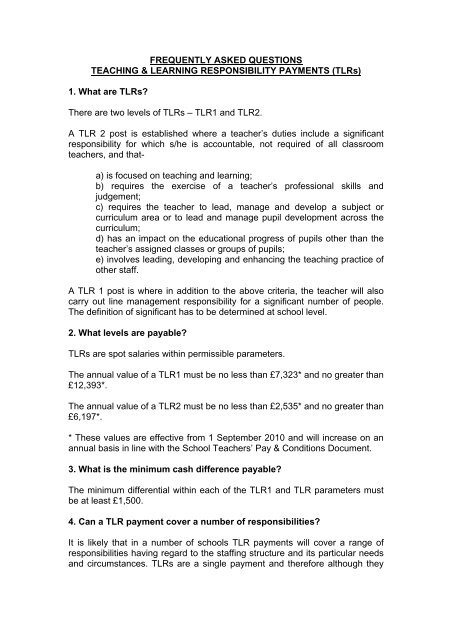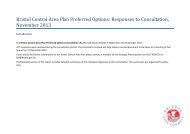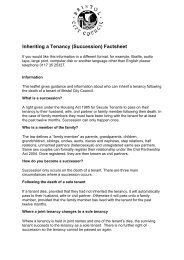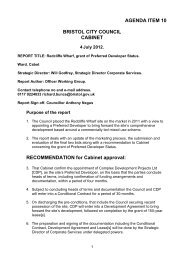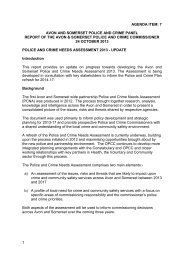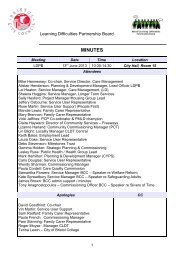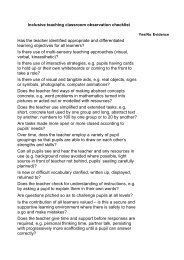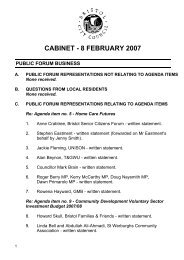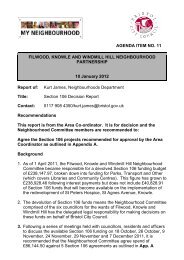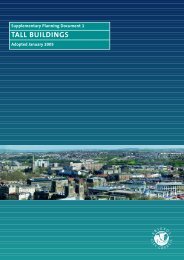FAQS - Teaching & Learning responsibility payments (TLRs)
FAQS - Teaching & Learning responsibility payments (TLRs)
FAQS - Teaching & Learning responsibility payments (TLRs)
You also want an ePaper? Increase the reach of your titles
YUMPU automatically turns print PDFs into web optimized ePapers that Google loves.
FREQUENTLY ASKED QUESTIONS<br />
TEACHING & LEARNING RESPONSIBILITY PAYMENTS (<strong>TLRs</strong>)<br />
1. What are <strong>TLRs</strong>?<br />
There are two levels of <strong>TLRs</strong> – TLR1 and TLR2.<br />
A TLR 2 post is established where a teacher’s duties include a significant<br />
<strong>responsibility</strong> for which s/he is accountable, not required of all classroom<br />
teachers, and that-<br />
a) is focused on teaching and learning;<br />
b) requires the exercise of a teacher’s professional skills and<br />
judgement;<br />
c) requires the teacher to lead, manage and develop a subject or<br />
curriculum area or to lead and manage pupil development across the<br />
curriculum;<br />
d) has an impact on the educational progress of pupils other than the<br />
teacher’s assigned classes or groups of pupils;<br />
e) involves leading, developing and enhancing the teaching practice of<br />
other staff.<br />
A TLR 1 post is where in addition to the above criteria, the teacher will also<br />
carry out line management <strong>responsibility</strong> for a significant number of people.<br />
The definition of significant has to be determined at school level.<br />
2. What levels are payable?<br />
<strong>TLRs</strong> are spot salaries within permissible parameters.<br />
The annual value of a TLR1 must be no less than £7,323* and no greater than<br />
£12,393*.<br />
The annual value of a TLR2 must be no less than £2,535* and no greater than<br />
£6,197*.<br />
* These values are effective from 1 September 2010 and will increase on an<br />
annual basis in line with the School Teachers’ Pay & Conditions Document.<br />
3. What is the minimum cash difference payable?<br />
The minimum differential within each of the TLR1 and TLR parameters must<br />
be at least £1,500.<br />
4. Can a TLR payment cover a number of responsibilities?<br />
It is likely that in a number of schools TLR <strong>payments</strong> will cover a range of<br />
responsibilities having regard to the staffing structure and its particular needs<br />
and circumstances. <strong>TLRs</strong> are a single payment and therefore although they
may cover a number of responsibilities, attempts to break the payment down<br />
to reflect each <strong>responsibility</strong> should be avoided.<br />
5. Can a teacher hold two TLR <strong>payments</strong>?<br />
No. It would, however be possible for two or more responsibilities to be<br />
amalgamated into a package, which meets the criterion and the factors and<br />
best services the particular needs and circumstances of the staffing structure.<br />
6. Can two teachers share a TLR payment?<br />
No, unless they are job-sharing a post which has a TLR attached. A TLR may<br />
not be shared between two full-time teachers or between a full-time and a<br />
part-time teacher.<br />
7. Can a part-time teacher be awarded a full TLR and be paid the whole<br />
amount?<br />
No, under the School Teachers’ Pay and Conditions Document the TLR<br />
amount must be pro-rata'd.<br />
8. Can there be temporary <strong>TLRs</strong>?<br />
No. <strong>TLRs</strong> can only be awarded to teachers who have significant<br />
responsibilities which are attached to posts in the staffing structure. This<br />
means that <strong>TLRs</strong> cannot be awarded on an unplanned or adhoc basis. Also,<br />
the responsibilities for which a TLR is awarded must be ‘sustained’. It would<br />
be unlikely to be possible to describe a <strong>responsibility</strong> as ‘sustained’ if it lasted<br />
for less than a year.<br />
Permanent TLR posts can however be awarded on a temporary basis to<br />
teachers who are temporarily undertaking the responsibilities attached to a<br />
post in the structure to which a TLR has been attached, for example to cover<br />
maternity or sick leave, a vacancy or secondment. Teachers who receive<br />
<strong>TLRs</strong> in such cases will not be subject to safeguarding when the TLR ends.<br />
9. What about posts that are subject to fixed term funding?<br />
Schools are encouraged to look to the longer term beyond particular streams<br />
of funding in driving the school’s staffing structure which should be designed<br />
to support the school’s wider development strategy on a sustained basis. If<br />
specific streams of funding are used to fund <strong>TLRs</strong> within the structure, the<br />
school will need to establish its strategy should the funding cease.<br />
10. What about specific improvement priorities or short-term projects?<br />
Schools can address improvement priorities, which may be shorter term, by<br />
making provision to deal with such issues in the job descriptions of TLR,<br />
advanced skills teachers, excellent teachers or leadership group postholders
as appropriate, if the responsibilities are significant. If the responsibilities are<br />
of a lesser order they maybe covered by other teachers in accordance with<br />
the duties that under the School Teachers Pay and Conditions Document they<br />
may be reasonably be required or expected to perform.<br />
11. Can a teacher have a TLR and an SEN allowance?<br />
Yes, SEN <strong>payments</strong> are awarded for the contribution to the teaching of pupils<br />
with special educational needs. <strong>TLRs</strong> are awarded to recognise the<br />
responsibilities undertaken by all staff undertaking a post to which a TLR is<br />
attached.


